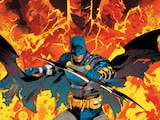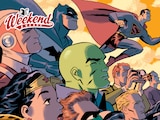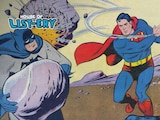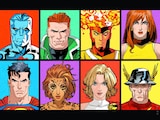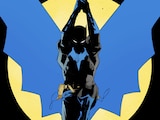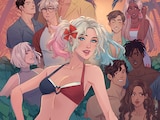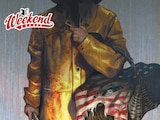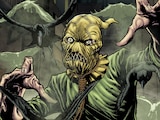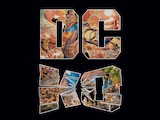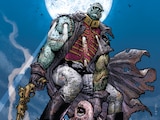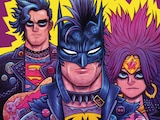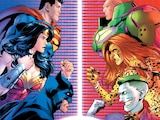Superheroes have always been a product of the times in which they were created and will go on to reflect the same cultural trends and social mores that their writers and artists are living through when they put pen to paper. Like any other product of the imagination, they are limited by the nearsightedness of the now, only registering hindsight years after the fact. But when stories are set decades after the period in which they take place, that’s when the benefit of time sets in and stories are able to take a more thoughtful approach to how they portray their era.
When superheroes and period pieces collide, the result is often political, and politics quickly become extreme when dealing with extreme circumstances. But it’s often done for a purpose, and that purpose can shout volumes the further it resonates with where we are now. This is John Ridley and Georges Jeanty’s The American Way.
The Premise:
The year is 1961. John F. Kennedy is president, and his brother Bobby is U.S. Attorney General. In this alternate universe portrayal of the Cold War, the country is protected by public superheroes who battle threats to the American way of life. Super-powered mystery men and women known as the Civil Defense Corps take to the skies and battle communist mad scientists and costumed creatures. Little do the public know that this is, in reality, all a fabrication by the government, who stage battles between heroes and villains in order to keep the country distracted with spectacle, unengaged with the threat of nuclear annihilation and a burgeoning race war.
One day, however, the scheme goes off-script and one of the heroes ends up dead on live television. Wes, an advertising agent who’s been recently brought onto the handling of the CDC by Bobby Kennedy, suggest they replace the fallen hero with a Black man. The plan was to have the country swept up by the new masked superhero named “The New American,” and—after a few years—reveal his race to the public and take a step forward in healing race relations, killing two birds with one stone. But the government’s scheme doesn’t go exactly according to plan, as the super-powered actors they’ve brought on are all too human. Before long, egos, biases and bigotries rear their ugly heads and threaten to not only expose the White House’s charade, but the larger moral weakness of the country itself that it represents.
Let’s Talk Talent:
John Ridley wrote this series back in the mid-2000s, during the George W. Bush administration. He took inspiration from the Iraq War and the handling of information by the media regarding the idea of heroism and what America stands for. With that understanding, it’s not surprising that this is the work of the same man who went on to do similarly politically charged books such as The Other History of the DC Universe and I Am Batman. In all three series, racial strife is the foremost cause of events that affect how our heroes are both treated and see themselves.
In The American Way, the New American is a young Black man named Jason Fisher, who is given super strength and invulnerability, but not without the removal of his pain receptors (part of a modicum of “insurance” by the government). In Jason, faithful readers of Ridley’s later work can see Karen Beecher, Jefferson Pierce, Jace and Tiffany Fox and Renee Montoya: people of color who find themselves in powerful but precarious positions to enact meaningful change, often at great risks to themselves or to the cause they’re fighting for. In lesser hands, this would make the books maudlin, dour or unpleasant to read, especially in this current political climate where issues such as police brutality and criminal politicians openly gaming the system shower our newsfeed daily. But Ridley excels at this, grounding the larger themes in interesting, likable and nuanced characters that help illustrate the complexity of the issue.
Georges Jeanty’s artwork lends a sublime, grounded touch to the story’s time period, with costume designs evoking that of the late Golden and early Silver Age of Comics. Through that evocation comes not only a believably rendered cast of characters, but the intensity of the times they embody beneath the veneer of “The Good Old Days.” The other superhero team in the story is the Southern Defense Corps, a group of heroes from the American South, and as the series goes on, the ugly sides of some of the members burns to the surface. With characters such as Southern Cross, Mighty Delta and the Captain—a time traveler in the guise of Mark Twain—Jeanty infuses both historical and classic stylings with comic book flare, cocktailing in a mix of both hagiographic nostalgia and unflinching realism not often seen since Dave Gibbons’ work on Watchmen.
A Few Reasons to Read:
- It’s a hell of a thing to read a comic with such an unapologetic punch towards a visibly corrupt system that in so many ways mirrors our own. Real world events such as the Tuskegee Experiment, the murder of Emmitt Till, the attack of Isaac Woodard and the conviction of the Scottsboro Boys are referenced with unflinching parallels to events understood by today’s reader.
- I compared the book to Watchmen earlier and I meant it. This series shares a seat at the table with the iconic alt-history comic, as well as similarly political superhero comics like DC: The New Frontier, The Boys and several others. All of them shine a light on the ugly truths of American history and its people.
- The American Way, for all its political undertones, is still a superhero comic, so you’ll see plenty of familiar archetypes. Pharos and Freya are obvious stands-ins for Superman and Wonder Woman, but as this is an alternate history with original characters, you can see how such archetypes might behave in the real 1961. How might Superman react as a public figure, to both women like Lois Lane (here a character named Tannis Darling) and Freya—who is nearly as strong as he is? How would time travelers view concepts such as mortality? In a racist society, would Black heroes work alongside white heroes and vice-versa? Is that even possible?
- The story also relishes in being highly unpredictable. There’s the death at the end of the first issue, which lays the groundwork that no one is safe. Nuclear war is continually a looming threat, with the Cuban Missile Crisis having a big impact in this world’s timeline just as it did in ours. Deaths, betrayals and surprise attacks can come at any moment, giving the limited series a wealth of cliffhangers at the end of every chapter.
Why It’s Worth Your Time:
The American Way is an angry, admonishing and scathing book, but a book that also demonstrates feats of true heroism, all the while pondering what it means to do the right thing—a question raised and engaged with by every major character. Is truth more important to maintaining a functioning society than the comfort that inequality brings? Is society’s idealized view of itself meant to die out in the future brought on by that society? All of these questions are unpacked by Ridley and Jeanty, who fearlessly utilize the superhero genre to tell a real American story of power, fear, progression and hatred. If you want to see the world of superheroes through the lens of our often-flawed world, The American Way cannot be recommended highly enough.
The American Way by John Ridley, Georges Jeanty and Karl Story is available in bookstores, comic shops, libraries and as a digital graphic novel. The limited series can also be read in full on DC UNIVERSE INFINITE.
Donovan Morgan Grant writes about comics, graphic novels and superhero history for DC.com. Follow him on Twitter at @donoDMG1.
NOTE: The views and opinions expressed in this feature are solely those of Donovan Morgan Grant and do not necessarily reflect those of DC Entertainment or Warner Bros.

